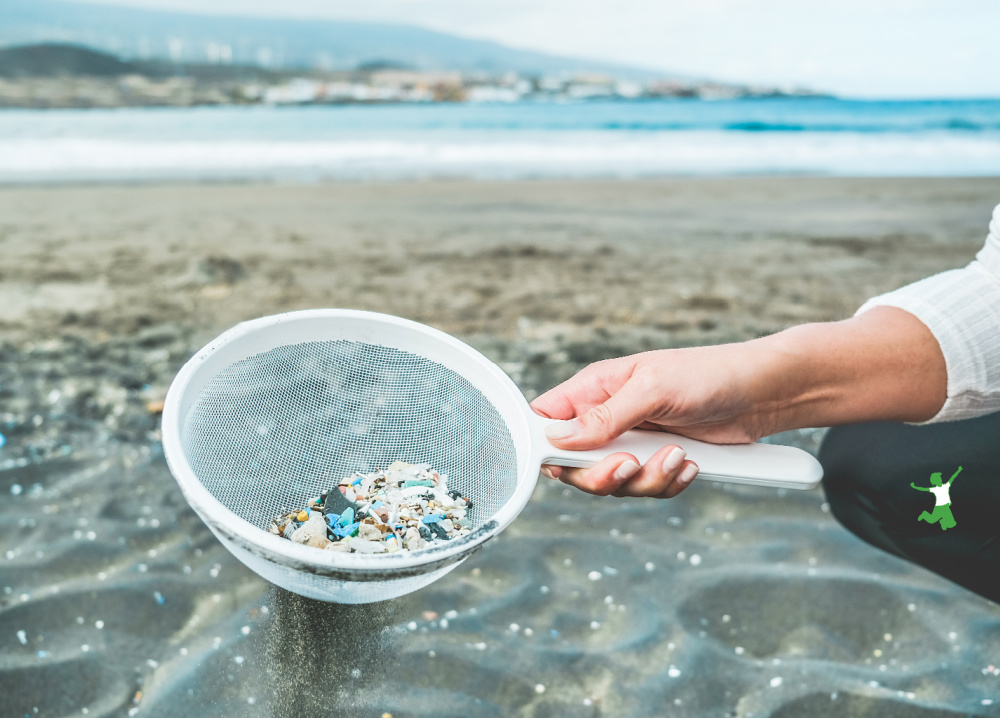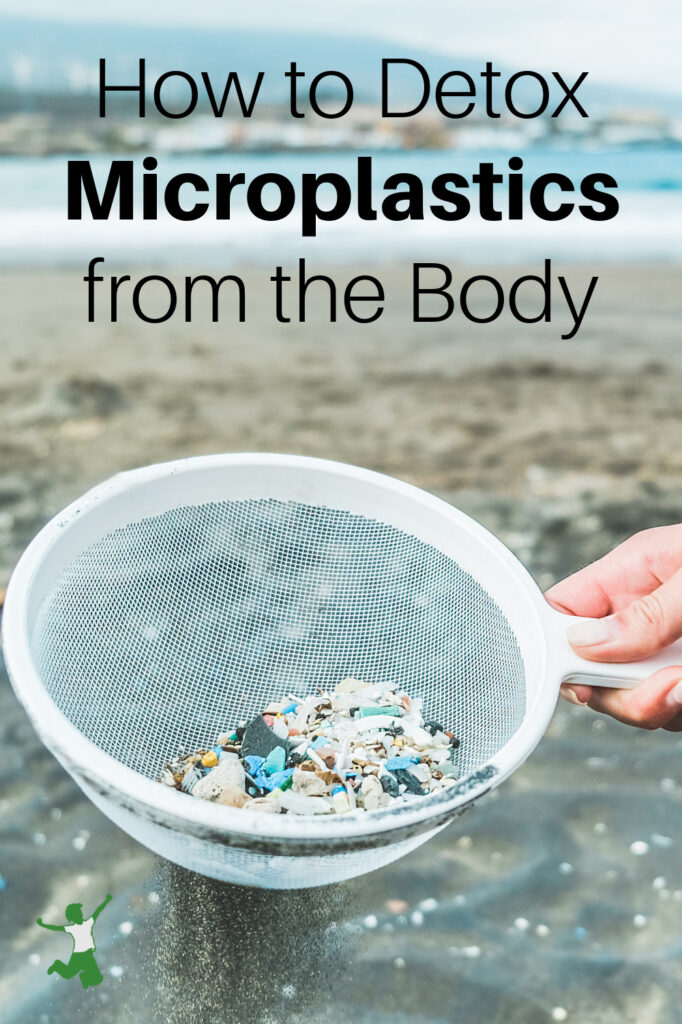How to detoxify microplastics from the body and vital organs via two research-backed methods of elimination.

When I first wrote about how to reduce your exposure to microplastics back in 2019, there was not a lot of research on it or what it might be doing to our bodies.
All we really knew at that time was that microplastics were everywhere (including the most pristine places on the planet like the North Pole) and that we desperately needed to reduce our exposure.
To give you a very concrete example, the average person eats roughly a credit card worth of microplastics…EVERY WEEK. (1)
Eliminating exposure is next to impossible given that the planet is now swimming in it.
“It’s in all of us and we can’t escape consuming plastics”, says Marco Lambertini, Director General of the Worldwide Fund for Nature. (2)
Recent Studies on Microplastics
So, where do the microplastics in our bodies go?
While some of it passes straight through you, the rest can end up pretty much anywhere.
This includes the brain.
Micro and nano-sized microplastic particles seem able to easily get past the blood-brain barrier, ending up in brain tissue within hours of ingestion. (3)
The method of entry is via cholesterol molecules.
Cholesterol located on the brain’s membrane absorbs the particles.
Then, the microplastics cross into the brain with cholesterol acting as a “Trojan Horse” of sorts.
The most recent research indicates that microplastics are also contaminating human sperm.
Every single sample in a small study involving 40 men contained microplastics! (4)
A total of eight different plastics were found in the seminal fluid samples.
The most prevalent was polystyrene, most commonly used for packaging like Styrofoam (skip the takeout folks!)
The polyethylene in plastic bags was the second most detected micro-particle (bring your own reusable bags when shopping and never EVER eat food cooked sous vide!).
The third was plastic from PVC, indicating that water from PVC pipes is a likely stealth contributor to human microplastic toxicity (filter your drinking and shower water or at least buy an older house with copper pipes!).
Note that exposure to microplastics from breathing contaminated indoor air is a major factor for exposure too.
Hence, having a quality HEPA filter for roughly every 500 square feet of living space (at least in the bedroom area) is a smart prevention strategy.
Best Ways to Eliminate Microplastics from Your Body
It seems sadly inevitable that living anywhere on planet Earth is going to expose you to nearly constant toxicity from microplastics.
Thus, knowing how to detox these particles is very important!
Moreover, the elimination process needs to be a regular aspect of your life since microplastics are being ingested and/or breathed in every single day in most cases.
Physical Removal of Plastic Particles
There is currently no method for the physical removal of plastic particles from the body like there is for heavy metals via chelation.
Thus, active avoidance of microplastics is still the most important strategy to protect yourself.
Despite the lack of any physical means to forcibly remove them, there are still two main ways to get microplastics out of the body!
Excessive Sweating
The most promising research to date shows that excessive sweating may be the most effective route for microplastic removal.
Studies have shown that the level of harmful plastic chemicals in sweat is higher even than in urine. This includes those situations where no plastic is detected in urine. (5, 6)
Most encouraging is that the sweat elimination of plastic compounds includes those that are from stored body tissues and fat…not just particles free-floating in the blood.
This is very good news!
Thus, sauna therapy (near-infrared models are best to avoid flicker eyestrain and high EMF from LED lights) and/or exercise that induces heavy perspiration appears to be your best methods of defense against the constant onslaught of microplastics.
Caloric Restriction
Besides heavy sweating, research has demonstrated that restricting calories brings plastic compounds out of the bodily tissues for the excretory channels to eliminate.
The caloric restriction can be achieved by fasting or a low-calorie (aka “calorie deficit”) diet.
Restricting calories a la intermittent fasting or for longer periods of time mobilizes plastic chemicals out of adipose (fat) tissue stores and into the bloodstream. (7, 8)
Once freed from the tissue, the compounds are brought to the skin, where the sweat eliminates them.
Combination Approach
Thus, the most effective microplastic detoxification regimen backed by research would employ a combination approach.
This includes some sort of fasting protocol along with heavy sweating (not necessarily at the same time).
Since it is summertime, this is a good time of year to use the hotter temperatures provided by Mother Nature to your advantage!
With intermittent fasting the most practical approach to consider in conjunction with perspiration, note that the research suggests that an earlier “eating window” is far better for health.
This means eating breakfast and lunch and skipping dinner (or eating supper early) rather than skipping breakfast and eating lunch with a late dinner, which typically entails going to bed with a full stomach.

(1, 2) Revealed: plastic ingestion by people could be equating to a credit card a week
(3) Micro- and Nanoplastics Breach the Blood-Brain Barrier (BBB): Biomolecular Corona’s Role Revealed
(4) Prevalence and implications of microplastic contaminants in general human seminal fluid
(5) Human Elimination of Phthalate Compounds: Blood, Urine, and Sweat (BUS) Study
(6) Human excretion of bisphenol A: blood, urine, and sweat (BUS) study
(7) Factors affecting the storage and excretion of toxic lipophilic xenobiotics
(8) Pharmacokinetics of 2,2′,4,4′,5,5′-hexachlorobiphenyl (6-CB) in rats with decreasing adipose tissue mass. I. Effects of restricting food intake two weeks after administration








I have been wondering about sous vide cooking and if it’s toxic by heating and cooking in plastic. Would you know? It also seems like a fairly new practice. Thank you
Great topic and great tips, very helpful. I did not know that sweat can help detox from micro-plastic and this is very good news. Nor I did know that they can cross the blood-brain barrier. Thank you for this very informative article.
Wow, I learned so much from this article. Thank you! I don’t believe you mentioned microplastic exposure from synthetic clothing. What do we know about how much of these types of plastics take up residence in the body?
Plastic dust from synthetic clothing is a big contributor to contamination of indoor air with microplastics. Thanks for mentioning!
Clothing from natural materials is so important. It’s more expensive, but you get what you pay for.
There is one more proven way to remove one element of plastic (PFAS) from the human body: whole blood and plasma donation. There was a small study done on firefighters not long ago demonstrating this.
Very interesting. But I wonder do they have a way to filter the blood to remove the microplastics
No, as many are nanosize.
Thanks for putting this on your regular website! My husband had a unique health problem last year. He lost a lot of weight fairly quickly through fasting and calorie restriction but then his ketones were dangerously high and stayed in the hospital for non-diabetic ketoacidosis. I really think his body was trying to get rid of toxins (probably micro plastics too!) but it was too much at once. We are still trying to get him fully back to health
Teens invent incredible device while searching for way to tackle one of the world’s most challenging sources of pollution: ‘Current solutions aren’t really effective’
Susan Elizabeth Turek
Thu, August 8, 2024 at 7:30 PM CDT
2 min read
A visit to a water treatment plant inspired a pair of Texas teenagers to develop a device to filter one of the most pervasive forms of toxic waste of modern times: microplastics.
As detailed by Business Insider, Victoria Ou and Justin Huang, who have been friends since elementary school, won $50,000 from the Gordon E. Moore Award for Positive Outcomes for Future Generations after showcasing their ultrasonic microplastics filter.
The duo revealed their device in May at the Regeneron International Science and Engineering Fair in Los Angeles in a remarkable display of young innovators working on projects to benefit humanity.